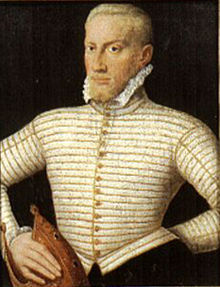Gebhard Truchsess von Waldburg
| Gebhard Truchsess von Waldburg | |
|---|---|
| Prince-Elector-Archbishop of Cologne | |

Gebhard's conversion and marriage triggered the Cologne War.
|
|
| Reign | 3 October 1577 – 1588 |
| Predecessor | Salentin VII of Isenburg-Grenzau |
| Successor | Ernst of Bavaria |
| Dean, Strasbourg Cathedral | |
| Tenure | 1574 |
| Provost, Augsburg Cathedral | |
| Tenure | 1576 |
| Born |
10 November 1547 Heiligenberg |
| Died | 21 May 1601 (aged 53) Strasbourg |
| Burial | Strasbourg Cathedral |
| House | House of Waldburg |
| Father | William Seneschal of Waldburg |
| Mother | Johanna von Fürstenberg |
| Religion |
Roman Catholicism (to 1582) Calvinism (from 1582) |
Gebhard Truchsess von Waldburg (10 November 1547 – 21 May 1601) was Archbishop-Elector of Cologne. After pursuing an ecclesiastical career, he won a close election in the Cathedral chapter of Cologne over Ernst of Bavaria. After his election, he fell in love with and later married Agnes von Mansfeld-Eisleben, a Protestant Canoness at the Abbey of Gerresheim. His conversion to Calvinism and announcement of religious parity in the Electorate triggered the Cologne War.
On 19 December 1582, a proclamation in his name established parity for Catholics and Calvinists in the Electorate of Cologne, causing a scandal in the Catholic Church and the Holy Roman Empire, and after his marriage in February 1583, he sought to convert the Electorate into a dynastic dignity. For the next six years, his supporters fought those of the Catholic cathedral chapter for the right to hold the electorship and the archdiocese in the so-called Cologne War or Seneschal War. After brutal fighting, plundering of villages, cities, and abbeys throughout the Electorate, Gebhard surrendered his claim on the electorate and retired to Strasbourg. He died there in 1601 and was buried in the Cathedral.
Gebhard's conversion and marriage was the first major test of the principle of ecclesiastical reservation established in the Peace of Augsburg, 1555. His loss of the Electorate strengthened the Catholic counter reformation in the northern German states, gave the Jesuits a stronghold in Cologne, and expanded the Wittelsbach family influence in imperial politics.
Gebhard was born in the Fürstenburg fortress of Heiligenberg, the second son of William, known as the younger, (6 March 1518 – 17 January 1566), Freiherr and Seneschal of Waldburg and an Imperial Councilor, and his wife, Johanna v. Fürstenberg (1529–1589). His family was an old Swabian house and he was descended from the Jacobin line of the House: Jakob I Truchseß von Waldburg, also known as the Golden Knight (for his blond hair). The family owned extensive properties that bordered on the Abbey of Kempten and various Habsburg territories in present-day southwestern Bavaria; In 1429 and 1463, the three surviving sons of Johann II, Jakob, Everhard, and George, and their surviving sister Ursula, concluded a covenant of inheritance to protect the family property. In the future, they would occupy and own the property as one; the inheritance of the daughters could not exceed 4000 gulden. They guaranteed each other the right of first refusal on potential property sales.
...
Wikipedia
